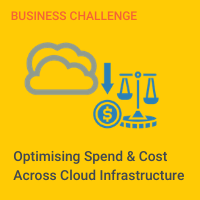
researchHQ Key Takeaways:
- Certain best practices, such as contextual use of resources and scheduling non-production instances, will help organisations optimise their cloud costs.
- Monitor the right metrics enables organisations to cut costs by identifying areas where downsizing is appropriate across their cloud infrastructure.
- The discounts offered by public cloud vendors offer a range of unique savings opportunities for organisations.
- Implementing a clearly defined tagging policy early on can save organisations hours of work and help allocate costs.
- Repeating these processes reduces wasted cloud spend as an organisation expands into the cloud.
Optimizing cloud costs is a never-ending adventure, but implementing cloud best practices from the beginning is the best way to stay ahead of the inevitable challenges.
Managing cloud infrastructure poses new challenges companies aren’t accustomed to with traditional data centers. In the cloud, costs are incurred when new infrastructure is launched regardless of whether or not it’s used. It’s easy to provision infrastructure and forget about it or to spin up instances that are too large for the task at hand.
Below are some key cost optimization strategies to ensure your finance and engineering teams can live in harmony. We’ve outlined each strategy and how you can utilize Flexera’s technology to assist you along your optimization journey.
1. Scheduling Non-Production Instances
Because you pay for what you’re using in the cloud, it’s important to ensure resources are turned on only when needed. If a virtual machine is being used for development, does it need to be on when your engineers aren’t actively working on it?
An easy way to begin cutting costs is to schedule your development, testing, staging and QA instances to shut down when not in use. Even if only for the weekend, you can reduce costs by almost 30 percent per instance. This allows for large cost savings by doing the bare minimum and the potential for much larger savings if you turn the instances off during weekday non-working hours.
Using Flexera’s policy engine, you can automate scheduling by simply specifying with a tag when the instance should be running and when it should be turned off. Our platform will take care of the rest for your multi-cloud environment.
2. Rightsizing Infrastructure
Deploying the right instance or database for the task at hand is easier said than done. Far too often, they don’t align and your organization is left paying for underutilized infrastructure. By monitoring the metrics of the machines you’re using, you’ll uncover what can be downsized to save money.
By downsizing an instance or database only one size, you can quickly cut costs by 50 percent. If you can downsize by two sizes, you’ll realize 75 percent savings. This is too significant of a savings opportunity to ignore, and one that’s better left to automation.
Flexera has out-of-the-box capabilities that allow your organization to downsize AWS, Azure or Google infrastructure. Whether it’s a virtual machine or a database, we have you covered. Our policies will downsize them for you based on metrics you set. The policies also have the capability to exclude resources based on tags and can require approval, ensuring nothing critical is terminated.








